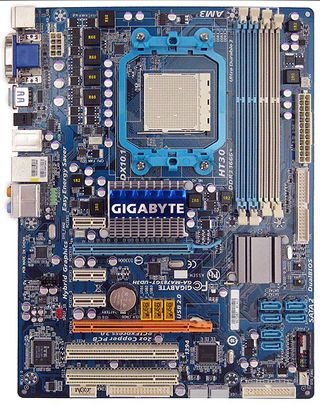Seven AMD 785G-Based Motherboards Rounded Up
Gigabyte GA-MA785GT-UD3H: Features And Hardware

Gigabyte's entry in the 785G roundup is the last full ATX-sized entrant, which offers 140W CPU support right out of the gate. The UD3H designation indicates Gigabyte's Ultra Durable 3 suite, including 50,000 hour Japanese capacitors, 2 ounces of copper in the board's inner layer, and Gigabyte's DualBIOS feature that makes worrying about a corrupt BIOS flash a thing of the past.
The only thing this board is missing is SidePort memory, which can be found on its sister model, the GA-MA785GPMT-UD2H.
As we've seen from some of the other boards in this story, sparse bundles are fairly common when you're looking at inexpensive motherboards. This one includes instruction manuals, a driver CD, an I/O shield, two SATA cables, and an IDE cable. There are no frills, but all the main bases are covered.
Other features include Easy Energy Saver (an AM2+/AM3 feature that disables extra power phases under light loads to save power) and EasyTune6 (Gigabyte's overclocking and resource monitor software).

The most fully-featured board in the roundup when it comes to connectivity, Gigabyte's product comes with all the trimmings: two x16 PCIe 2.0 graphics card slots [edit: The blue PCIe slot offers full 16x bandwidth, while the orange slot is limited to 4x bandwidth. This will likely have a negative effect on CrossFire performance compared to two 16x or even two 8x slots], three x1 PCIe slots, two legacy PCI slots, two FireWire ports (one internal), internal serial and parallel connectors, floppy and IDE ports, and six SATA ports. Gigabyte didn't skimp on the audio codec either, using Realtek's premium ALC889A on-board.
When it comes to the layout, Gigabyte did a good job cramming all of the options in the available space without making anything terribly hard to access. The 24-pin ATX power connector is well-placed, as are the IDE and SATA connectors, all facing the user. Just bear in mind that a long graphics card in the second PCI Express slot will likely cover the bottom two SATA ports, rendering them unusable.
The less-likely-to-be-used items, such as the parallel and serial connectors, are out of the way on the bottom of the board. The only complaint we have in this department concerns three internal USB connectors, which are located above the second graphics card slot. Should the user plan on a CrossFire setup, it'll complicate the USB wiring a bit.
Stay on the Cutting Edge
Join the experts who read Tom's Hardware for the inside track on enthusiast PC tech news — and have for over 25 years. We'll send breaking news and in-depth reviews of CPUs, GPUs, AI, maker hardware and more straight to your inbox.
Current page: Gigabyte GA-MA785GT-UD3H: Features And Hardware
Prev Page Foxconn Cinema Premium: BIOS And Overclocking Next Page Gigabyte GA-MA785GT-UD3H: BIOS And Overclocking-
JohnnyLucky Very informative article. Nice to see there are motherboards with different features for different users/tasks.Reply -
bpdski Great article, I think this shows pretty conclusively that there is no benefit to upgrading to an AM3 based system. If you already have an AM2+ system, you can easily just drop in a new CPU and you system will be every bit as good as a brand new system with DDR3. You just need to make sure your motherboard supports the power requirements of whatever you want to drop in.Reply -
jonpaul37 Hooray AMD for having cheap solutions in these hard-economic times!Reply
Boo @ Intel! i like the product, but my wallet & Girl do not like the cost! -
jonpaul37Hooray AMD for having cheap solutions in these hard-economic times!Boo @ Intel! i like the product, but my wallet & Girl do not like the cost!+1Reply
Girl has more money for clothes! -
ominous prime Well bpdski there is no point upgrading if you're AM2, but if you're building a new PC AM3 is the way to go in terms of your computers longevity. Very informative article.Reply -
sonofliberty08 thanks alot for the info , my first choice was allways asus , but now i now what i need when im going to unlock core , and now i saw the benefits of sideport memory .Reply -
duzcizgi ReplyWe were successful in achieving a 900 MHz stable overclock with the integrated graphics chipset by setting the BIOS to increase northbridge voltage by +.210mV.
Well, .210 mV = 210 microvolt. I don't think it would make much of a change. Maybe it is 210 mV or, .210 V. :) -
doron "Now we're seeing another benefit for the AM2+/DDR2 boards: both the Foxconn Cinema Premium and Biostar TA785GE 128M are drawing less power than their AM3/DDR3 counterparts."Reply
How comes? Didn't we all agree a long time ago that ddr3 supposed to be more energy efficient out of the two? (Lower voltage and stuff?) -
DarkMantle Great article, this will help a lot of people to make their AMD budget motherboard choice easier, thank you Don.Reply
Most Popular

